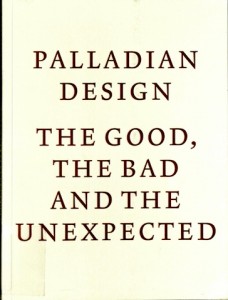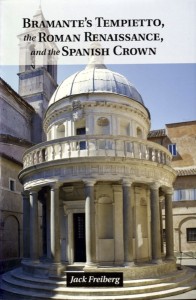Architecture and Planning recently received two texts assocciated with recent exhibits on Andrea Palladio from the Royal Institute of British Architects and the Palladio Museum, respectively.
Mortensen, Marie Bak, ed. Palladian Design: The Good, The Bad and The Unexpected. London: RIBA, 2015.
 Guido Beltramini, who is one of the editors of Jefferson and Palladio (below), Pier Vittorio Aureli, and Daniel Maudlin each contribute a short essay to the catalog. Mortensen notes that each author was selected to offer a specific reading of Palladio’s work and influence. She writes, “The contributed essays are not beholden to the exhibition’s raison d’être. Rather, they are intended as fresh contributions to a continuing polemical conversation around Palladio and Palladianism, which extends beyond the curated confines of any single exhibition project.” (Mortensen, Charles Hind, and Vicky Wilson, “Introduction,” 9.) The catalog primarily focuses on the content of the exhibit itself. Accordingly, “Through three themed sections this exhibition introduces Palladio’s unique design principles and explores the very different ways in which they have been interpreted, copied and re-imagined, and how they continue to inspire architects today.” (“Palladian Design: The Good, the Bad and the Unexpected,” 22.) The three themes include Revolution (subset themes: Andrea Palladio: Reinventing Antiquity; The Rise of Anglo-Palladianism; Spreading the Word), Evolution (subset themes: Bending the Rules; From Architectural Ideal to a Choice of Style; Statement Architecture; Pattern Book Architecture), and Eternally Contemporary (subset themes: The Comfort of the Familiar; Postmodern Palladianism; Abstract Palladianism).
Guido Beltramini, who is one of the editors of Jefferson and Palladio (below), Pier Vittorio Aureli, and Daniel Maudlin each contribute a short essay to the catalog. Mortensen notes that each author was selected to offer a specific reading of Palladio’s work and influence. She writes, “The contributed essays are not beholden to the exhibition’s raison d’être. Rather, they are intended as fresh contributions to a continuing polemical conversation around Palladio and Palladianism, which extends beyond the curated confines of any single exhibition project.” (Mortensen, Charles Hind, and Vicky Wilson, “Introduction,” 9.) The catalog primarily focuses on the content of the exhibit itself. Accordingly, “Through three themed sections this exhibition introduces Palladio’s unique design principles and explores the very different ways in which they have been interpreted, copied and re-imagined, and how they continue to inspire architects today.” (“Palladian Design: The Good, the Bad and the Unexpected,” 22.) The three themes include Revolution (subset themes: Andrea Palladio: Reinventing Antiquity; The Rise of Anglo-Palladianism; Spreading the Word), Evolution (subset themes: Bending the Rules; From Architectural Ideal to a Choice of Style; Statement Architecture; Pattern Book Architecture), and Eternally Contemporary (subset themes: The Comfort of the Familiar; Postmodern Palladianism; Abstract Palladianism).
Beltramini, Guido and Fulvio Lenzo, eds. Jefferson and Palladio: Constructing a New World. Vicenza: Centro internazionale di studi di architetttura Andrea Palladio; Milano: Officina Libraria, 2015.
I have not been lucky enough to see Palladio’s work in person;  rather, my engagement with his architecture has been through the lens of Thomas Jefferson. I was, thus, excited to see Jefferson and Palladio: Constructing the New World come through our new books. Beltramini and Lenzo, write, “The ‘seasons’ of the relationship between Jefferson and Palladio are revisited, focusing on the thread of affinity and a shared vision in their project to build a new world based on the example provided by the ancients.” (“Preface,” 10.) The work includes numerous articles with contributions by James S. Ackerman, Richard Guy Wilson, and Bruce Boucher. The book also includes a photo essay by Filippo Romano and documentation of the works designed by Jefferson.
rather, my engagement with his architecture has been through the lens of Thomas Jefferson. I was, thus, excited to see Jefferson and Palladio: Constructing the New World come through our new books. Beltramini and Lenzo, write, “The ‘seasons’ of the relationship between Jefferson and Palladio are revisited, focusing on the thread of affinity and a shared vision in their project to build a new world based on the example provided by the ancients.” (“Preface,” 10.) The work includes numerous articles with contributions by James S. Ackerman, Richard Guy Wilson, and Bruce Boucher. The book also includes a photo essay by Filippo Romano and documentation of the works designed by Jefferson.


